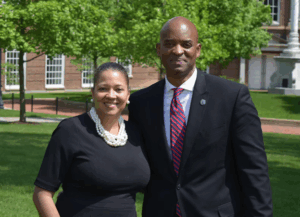
MILL VALLEY, Calif. (BP)–A “Great Commission strategy” — featuring age-based Sunday schools, the revival of Sunday school as an evangelistic tool and a change of focus from style to passion — is critical to reversing the decline and plateauing of many churches today, Ken Hemphill said at Golden Gate Baptist Theological Seminary in Mill Valley, Calif.
Hemphill, president of Southwestern Baptist Theological Seminary in Fort Worth, Texas, and a church growth expert, spoke to Golden Gate students, faculty and Christian education specialists in the West as part of the seminary’s Christian education lectures April 7-9.
“We’re at a point where we have a need for resuscitation,” said Hemphill, who worked as director of the Southern Baptist Center for Church Growth in Atlanta for two years before becoming president at Southwestern. “Two-thirds to 80 percent of churches, Southern Baptist or not, are plateauing or declining. Evangelism continues year by year according to the North American Mission Board to lag behind our population growth.”
Between 1960 and 1990, church membership grew by 28 percent, but the population grew by 39 percent, Hemphill said. Church plants are behind as well; more than 96,000 more churches need planting across the country to keep the same ratio of churches to people from 1960, he said.
The Sunday school figures concerned him the most, Hemphill said. From 1940 to 1960, Sunday school attendance jumped from 3.5 million to 7.5 million. But by 1980, it remained at 7.5 million and has only risen to 8 million since.
“Reality is we have the symptoms saying we need a cure. But we’re in a debate over the cure instead of finding the solution.”
He refused to get into debate over whether to use Sunday schools or cell groups, as well as whether churches should have seeker-oriented versus believer-oriented services and traditional worship versus contemporary worship.
“There’s little time for debate. Our vital signs are declining and there’s a lost world needing to hear the gospel. We’re not dealing with an either-or question. We need a both-and solution.”
The real issue is God finding people to respond to his own initiatives, Hemphill said. “The character issue must come first. There is no lasting change without an inner transformation. We want to change the methodology before the character changes. The methodological change is not going to work in your church unless there’s a heart transformation.”
Using passages from Acts 11-13, he said church growth was never a goal of the early church. It was simply a byproduct of God’s blessing.
“Our motives are suspect if our goal is to grow the church. There’s nothing the church ever does in Acts that it did to grow, yet the Lord was adding to their number daily. They were paying attention to fellowship and doctrine before any of them know about marketing and models.”
The New Testament church, Hemphill said, was a “character” church we need to emulate.
“There was an awareness of supernatural empowering. They saw the grace of God. I think Barnabas saw the Lord’s Supper with Jews and Gentiles eating together, and it blew him away. Barriers were removed instantly. It’s something you can’t explain with marketing and models. It has to be God.”
Other characteristics today’s church should adopt include powerful prayer, lay and pastoral biblical leadership, healthy community relationships, discipleship commitment and a Great Commission vision, Hemphill said. There was also passionate praise in the New Testament church that transcended issues of style, he said.
“At least the worship debate has us focusing on worship again, but we’ve missed the point,” Hemphill said. “It’s not style. Some churches use the shape-note hymnals and some use overheads, but they’re all dead without an expectancy of God working.”
Evangelistic passion also existed. “Passion precedes vision. Passion ignites the church; vision statements don’t,” Hemphill said.
It’s a matter of compassion, he continued, of regaining God’s eyes of seeing people as they really are. Therefore, a church should anchor its vision in the Great Commission, he said.
“This ensures a reliance on supernatural empowering. The greatest deterrence to church growth today is our disbelief that God is (only) a God of the past.”
A Great Commission-type vision also creates a balanced strategy between evangelism and discipleship, which both play central roles in the Great Commission in assimilating people into the church, Hemphill said.
“Churches are too often imbalanced and, therefore, self-delusional. Churches that focus too much on evangelism may lead in baptisms, but may also have a somewhat flat attendance. People may complain that the pastor neglects their needs. They argue that they love souls, but the failure to assimilate them proves the lie. Churches that focus too much on discipleship, however, are not developing authentic disciples. A disciple is like his master, and Jesus came to seek and save the lost.”
Hemphill said he believes the Sunday school can be a primary tool for providing balance in the church. Its organizational structure allows the class to delegate tasks for outreach and inreach and, therefore, simplifies scheduling and creates a team spirit. He also said churches vastly underutilize Sunday schools as evangelistic tools.
Historically, he said, English churches used Sunday schools to teach poor children basic literacy skills. The American church used the Bible as a textbook, and the children became Christians. Baptists expanded it to adults with evangelism as the primary purpose.
“But in the 1960s, it changed to a fellowship model, and it stagnated. The purpose ultimately rules the strategy.”
The only way that the plateau/decline trend can be reversed is through prayer and awakening, Hemphill said. They create a can-do attitude in a congregation and eliminate any excuses because God is all-powerful.
Hemphill then gave an organizational plan for Sunday schools to fit an evangelical purpose. He said a Sunday school structure should be simple and comprehensive, yet flexible enough to make the creation of new classes or units natural.
“A lot of organizational strategies must be redesigned when it grows,” he said. “And we know that new units grow more quickly than old units because it’s harder to penetrate into older units.”
That is one of the known growth principles the programs should follow. Others it should realize are that growth is a process and not an event, small-group involvement enhances overall attendance, groups should respond to the most receptive members or prospects quickly, they should have enough leaders and they must properly apply the misused homogeneity principle.
” It doesn’t mean that we can’t reach out to ‘different’ people,” Hemphill said. “It suggests, rather, that the gospel flows through relationships. It means you should start a Bible study in a trailer park rather than one in a church for those living in one.”
Hemphill suggested that the church return to having age-based Sunday schools since most of the other methods have primary flaws.
“Scholastic attainment works through college, but what about after that? Groups based on social relationship or congeniality easily become cliques and are impenetrable for new people. Groups based around geography misuse the homogeneity principle. Groups based on spiritual maturity work for baby Christians, but how do you grade everyone else?”
Even the popular topical interest or special needs groups are flawed, he noted.
“Get a group together and they build deep relationships pretty quickly, so it works pretty well for six to eight weeks. But when you introduce someone new, for two or three weeks there is a lack of trust, and that keeps happening. So the class stays sick all the time. And you have to reorganize it every 13 weeks.”
Hemphill said there are many advantages to age-graded Sunday schools. It’s easy to explain to first-time visitors, and it helps develop relationships and counteract stagnancy. It also is a natural system that caters to similar spiritual needs and can be easily reorganized. Furthermore, it properly uses the homogeneity principle, he said.
“Young couples look for young couples. It tries to get people at a common point in life together.”
The teacher is the key to how successful a class would be, but also inreach and outreach leaders in the class focus on assimilation and evangelism, respectively, Hemphill said.
“This is the simplest way to do church. We just need to rediscover an old principle. It works for evangelism, assimilation and teaching.”











